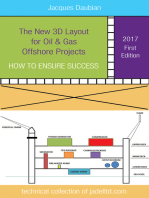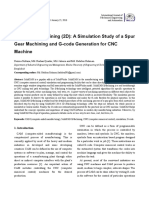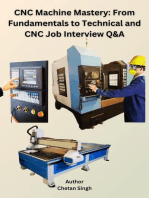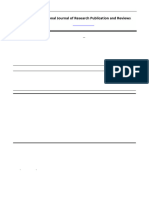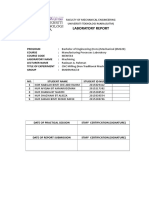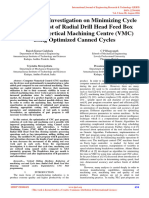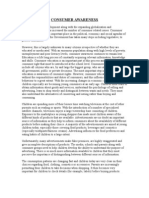Automatic Automatic Generating CNC-Code For Milling MachineGenerating CNC Code For Milling Machine
Uploaded by
Vikas Singh SisodiaAutomatic Automatic Generating CNC-Code For Milling MachineGenerating CNC Code For Milling Machine
Uploaded by
Vikas Singh SisodiaWorld Academy of Science, Engineering and Technology
International Journal of Mechanical, Aerospace, Industrial, Mechatronic and Manufacturing Engineering Vol:7, No:12, 2013
Automatic Generating CNC-Code for Milling
Machine
Chalakorn Chitsaart, Suchada Rianmora, Mann Rattana-Areeyagon, Wutichai Namjaiprasert
International Science Index, Industrial and Manufacturing Engineering Vol:7, No:12, 2013 waset.org/Publication/9997088
AbstractG-code is the main factor in computer numerical
control (CNC) machine for controlling the toolpaths and generating
the profile of the objects features. For obtaining high surface
accuracy of the surface finish, non-stop operation is required for
CNC machine. Recently, to design a new product, the strategy that
concerns about a change that has low impact on business and does
not consume lot of resources has been introduced. Cost and time for
designing minor changes can be reduced since the traditional
geometric details of the existing models are applied. In order to
support this strategy as the alternative channel for machining
operation, this research proposes the automatic generating codes for
CNC milling operation. Using this technique can assist the
manufacturer to easily change the size and the geometric shape of the
product during the operation where the time spent for setting up or
processing the machine are reduced. The algorithm implemented on
MATLAB platform is developed by analyzing and evaluating the
geometric information of the part. Codes are created rapidly to
control the operations of the machine. Comparing to the codes
obtained from CAM, this developed algorithm can shortly generate
and simulate the cutting profile of the part.
KeywordsGeometric shapes, Milling operation,
changes, CNC Machine, G-code, and Cutting parameters.
Minor
I. INTRODUCTION
N the situation of competitive world with increasing in
population, the consumers requirement has become a vital
influence for a manufacturer to position a new product onto
the market and try to satisfy customers expectations with
containing high quality and providing good services. For
supporting these circumstances, a manufacturer has been
forced to rapidly develop and create new technologies and add
an extra function onto the existing machine for enhancing its
performance.
Recently, the traditional machining processes such as
drilling, milling, turning, and joining processes have been
applied for manufacturing various types of products which are
required from different demands. These machines have been
operated and controlled manually by human for turning on/off
shaft controller, adjusting the feed rate, and turning on/off the
coolant. Before performing manufacturing activities, the
operator is required to understand the fundamental concepts
and other important functions of the machines used in the
process for the safety purposes. The skilled operator is
required for minimizing the resources and the reproduced part.
To obtain high quality of the surface finish, cutting parameters
S. Rianmora is with Sirindhorn International Institute of Technology,
Thammasat University, Pathumthani, Thailand. (Corresponding author phone:
(66-2)5643221-9, e-mail: suchada@siit.ac.th).
International Scholarly and Scientific Research & Innovation 7(12) 2013
(e.g., feed rate, spindle speed, or depth of cut) and the
maintenance activities should be well-prepared for operation.
However, the traditional machining process is error-prone
process where the possibility of the failed products is
relatively high due to inadequate operations, dimensions, and
surface finish [1], [2]. This has led to an alternative machining
process called computerized numerical control (CNC)
technology. CNC machine has been applied in all industries
for fast production processes. The concept of this machine is
about reading thousands of bits of information stored in the
computers memory. The program consists of code commands
(i.e., G-code) which are a series of instructions interpreted
from the human language to be the machine language.
However, G-code is quite difficult for the user to generate
since it requires the background knowledge in computing and
programming.
In general, G-code is generated by computer aided
manufacturing (CAM) where the computer software is applied
for controlling machining tools and machine to produce a part.
The input of CAM is the 3D virtual model. Once, the minor
changes of geometric mold and die are required (e.g., the
length and height), it becomes a very time-consuming for
reconstructing all processes starting from creating CADdrawing until generating G-code. So, it would be better to
change only geometric parameters or some dimensions of the
design directly through the simple platform.
The automatic G-code programming has been introduced as
a user-friendly application which can be easily implemented
on a clear platform (i.e., MATLAB). Using this developed
platform can minimize time for editing the codes since recreating CAM application is not required.
II. RELATED WORKS
Over the past ten years, the traditional machines have been
used to produce the various features and shapes of the parts.
Skilled operator and cutting parameters are the key
components of the operations to obtain high quality of the part
and to minimize reproduced part. For a complex shape,
repositioning the part on the platform is required and it is very
time consuming since setting up and calibrating the machine
and cutting tool are required for every operation .
To quickly generate the entire part, casting technique is
applied. In this process, the metal is melt and then poured into
the provided cavity or mould which should be perfectly dried
and be able to withstand the heat of the metal. In fact, the
casting process provides less surface accuracy and it cannot
control burr on the cast part. It spends very long time to get
2607
scholar.waset.org/1999.8/9997088
International Science Index, Industrial and Manufacturing Engineering Vol:7, No:12, 2013 waset.org/Publication/9997088
World Academy of Science, Engineering and Technology
International Journal of Mechanical, Aerospace, Industrial, Mechatronic and Manufacturing Engineering Vol:7, No:12, 2013
one product. When the errors are found, all steps are repeated
starting from the beginning [3].
To easily cut and obtain high surface accuracy, the extra
component of the cutting machine called metal working latch
was invented for holding the workpiece during the operation
[4]. After the traditional period, the rapid-improvement
machines have become as new solutions for supporting the
operation of several shapes of the workpiece over the casting
processes. Drilling, turning, milling, and grinding machines
have been applied for easily adjusting the cutting parameters
and also providing sharp-edge shapes and these machining
processes require low set-up cost and time comparing to
forming, molding, and casting processes. However, these
machining processes are more expensive for high volumes
where skilled operator is required for reducing wastes and
producing high tolerance on dimensions and surface finishes
[5].
In order to reduce processing time, cost for the waste
material and human-labor required, computerized numerical
control (CNC) machines have been introduced as the
technology for producing the product due to the commands
obtained from the computer analysis [6].
The two main objectives of applying CNC machine in
cutting operation are to eliminate some human errors, and
provide high surface accuracy of the part.
The input of this CNC operation is 3D CAD model which is
then used for analyzing, calculating, and generating the
toolpaths (i.e., program for cutting process). After obtaining
the program, the CNC machine works by reading the
thousands of bits of information stored in the program
computer memory. To place this information in the memory,
the programmer creates a series of instructions or commands
where the machine can understand.
The program may consist of code commands or G-code,
such as "M03" which instructs the controller to move the
spindle to a new position, or "G99," which instructs the
controller to read an auxiliary input from some process inside
the machine. Code commands are the most common way to
program a CNC machine tool. However, the advancement in
computers has allowed the machine tool manufacturer to offer
"conversational programming," where the instructions are
similar to the plain words [7], [8].
In conversational programming, the "M03" command is
entered simply as "MOVE," and the "G99" command is
simply "READ." This type of programming allows faster
training and less memorizing of the code meanings by the
programmers. The difficulties and errors (e.g., selecting the
wrong function provided onto the machines screen,
transferring the wrong codes, setting the wrong cutters
positions, assigning the wrong tool length, or creating the
wrong toolpaths) are always presented at the initial of the
CNC operation and the manufacturer have tried to generate the
codes to be in simple formats from a compactable 3D virtual
model. In general, codes for controlling machine contain the
cutting tools applied, size and shape of the object, the
properties of material, the toolpaths, and the starting/finishing
points. They all are interpreted into the computer commands
International Scholarly and Scientific Research & Innovation 7(12) 2013
rapidly through computer aided manufacturing (CAM)
application when the input model is available [9], [10]. The
simulation of the cutting process which mentions about
function, status, and sequences can also performed by this
application before starting real cut.
In order to support mass production process where the
maintenance activities can be well performed, the components
of CNC machine have been developed and redesigned for
providing quick and easy access. Mills typically consist of a
table that moves in the X and Y axes, and a tool spindle that
moves in the Z (depth). In order to provide highly accurate
movements, the position of the tool is driven by motors with a
series of step-down gears, or direct-drive stepper motors [8][10].
The new CNC systems, currently, are completely
electronically controlled. CNC-like systems are used for any
processes that can be described as a series of movements and
operations. These include laser cutting, welding, friction stir
welding, ultrasonic welding, flame and plasma cutting,
bending, spinning, pinning, gluing, fabric cutting, sewing, tape
and fiber placement, routing, picking and placing (PnP), and
sawing [11]. CNC machines have many advantages [12], [13],
such as producing the complex shapes/parts with less human
required, reducing the lead time and the production time, and
providing safety function for the user. The newest machine
can be set up fast enough to be used just in time
manufacturing environment, thus the inventory costs can be
reduced. Since the pneumatic controlling system has been
applied for CNC machine, urgent activity that disturbs
machine during the operation can cause some errors and
damages to the machine [14], [15]. When the machine stops
immediately, some functions are definitely skipped to
stopping-mode. To continue machining process, the entire
steps are required. These activities are very time-consuming
even for the simple geometric shapes of the part.
Pausing-mode application should be provided in CNCmachining function for easily performing some extra activities
(e.g., cleaning stuck chips or changing some codes) which
may occur during the operation, and machine can quickly
resume to process again. Using this concept can increase the
efficiency of the production process with maintaining high
quality, reducing time, and cost of the product. This has led to
our research which is about the automatic generating CNCcodes for milling machine where the machine can be paused
and resumed immediately after a minor corrections or
activities performed. The overall concept will be discussed in
the next section.
III. RESEARCH CONCEPT
When the machine is asked to cut the part that contains the
same shape of the previous design but the size is different, the
new CAD model is to be redesigned and recreated. It is timeconsuming for regenerating the new set of the G-codes for
CNC machine since the new design is changed only
dimensions. In order to reduce the time and avoid back-andforth process, the alternative technique for editing or
modifying G-code by using MATLAB program has been
2608
scholar.waset.org/1999.8/9997088
International Science Index, Industrial and Manufacturing Engineering Vol:7, No:12, 2013 waset.org/Publication/9997088
World Academy of Science, Engineering and Technology
International Journal of Mechanical, Aerospace, Industrial, Mechatronic and Manufacturing Engineering Vol:7, No:12, 2013
T
TABLE
I
GEOMEETRIC SHAPES
inntroduced in thhis research. The
T users willl be allowed to
t input
annd change paarameters of simple
s
geomeetric shapes without
w
reeconstructing CAD
C
models and G-code due
d to minor chhanges.
Thhe strong kno
owledge abouut CAD, CAM
M or G-codee is not
reequired. The user
u just needss to know the shape, size, raadius of
w
work
piece, raddius of diametter tool and otther basic paraameters
w
which
are all basic
b
informaation. For thee regular channnel of
m
manufacturing
process, a CA
AD model is firstly requirred and
G
G-code
is thenn generated byy CAM appliccations [16]-[[18] for
innputting to thee CNC machinne. G-code is used
u
as comm
mands to
coontrol movem
ment of cuttiing tool and operation inn CNC
m
machine
so caalled toolpathss [19]. Usingg this techniq
que can
prrevent the duuplicate activvities which are
a recreatingg CAD
m
model
or regenerating CAM simulation.
a
thhe proposed technique,
t
fouur main
In order to accomplish
steps are required; creatingg command based
b
on MA
ATLAB
t
sim
mulating
prrogram, generrating G-Codde to get a toolpaths,
neew G-code in
i the interfaacing program
m, and settin
ng and
opperating CNC
C machine. Illustrated in Fig.
F 1 is the overall
prrocess of this research. MATLAB
M
plaatform is askked for
prrogramming thhe design of tthe simple com
mmands that provide
p
thhe questions foor filling the desired
d
shape and their dim
mensions
froom the user. MATLAB caalculates the input
i
data andd it can
prrovide the function foor automaticaally changinng the
diimensions (according to maathematical foormulas of geoometric
shhapes) in thee same ratio with templaate. The inteerfacing
prrogram (e.g., CIMCO proggram) is then attempted to change
thhe toolpaths and control the operationn according to
t new
diimensions whhich are just assigned on MATLAB pllatform.
Soo, this interfaacing program
m will save thhe time for addjusting
annd re-creating the geometricc shape in CA
AD applicationn.
g
shaapes as
The geomettric shapes (e.g., basic geometric
shhown in Tablle I) are usedd as sample models for creating
c
M
MATLAB
plaatform to tesst these research conceptts. The
M
MATLAB
platfforms have beeen created too allow user innputting
thhe data Then MATLAB
M
is aautomatically asked for gennerating
a new set of the
t G-codes to
t control thee operation onn CNC
m
machine.
Somee questions aree raised duringg the process such as
hoow to know whether or not the commands written or
foormulas applieed are correcct. The drawnn virtual mod
dels are
prresented and checked theiir coordinatess. These moddels are
ussed as the refeerence data for cutting proffile parameterss which
arre required forr CNC-millingg operation. CIMCO
C
prograam [20]
is used to simuulate the toollpaths. The obtained G-codes are
mmands
ussed for operatting CNC maachine by sennding the com
diirectly from the computeer to the CN
NC machine. After
coompletely settting the positioons of the maachine and woorkpiece
onn work table, the machine starts operatiing to cut the profile
onnto the workpiece.
T
Type
Poolygon
(with fillet at every corner)
Pyramid polygon and frustum
m
(without filleet at every cornerr)
Pyramid polygon and frustum
m
(with fillet at every corner)
Cone andd frustum cone
Hemispheere and frustum
hem
misphere
Trapezoid
Pyramid trappezoid and frustum
m
E
Ellipse
Combiined shapes
IV. APPPLICATION OF THE PROPOSEED TECHNIQUEE
In this secction, four topics are presented; creating
c
coommands baased on M
MATLAB, generating
g
G
G-code,
sim
mulating new
w G-code in thhe interfacingg program (CIIMCO),
annd setting and operating on CNC machine.
International Scholarly and Scientific Research & Innovation 7(12) 2013
2609
scholar.waset.org/1999.8/9997088
Models
International Science Index, Industrial and Manufacturing Engineering Vol:7, No:12, 2013 waset.org/Publication/9997088
World Academy of Science, Engineering and Technology
International Journal of Mechanical, Aerospace, Industrial, Mechatronic and Manufacturing Engineering Vol:7, No:12, 2013
F 1 Four mainn steps of the reesearch
Fig.
A. Creating Commands
C
Baased On MATL
TLAB
MATLAB program is useed for creatingg simple com
mmands,
w
G-cod
de for operatin
ng CNC
caalculating, connverting, and writing
m
machine.
MATLAB platform
p
conccludes the num
mbers of synntax. In
orrder to create commands onn MATLAB platform, threee main
paarts are requirred; inputting parameters, calculating
c
daata, and
coonverting as shhown in Fig. 2.
2
The platform
m provides some questionns for assigniing the
baasic parameterrs of the objeect such as shhape, and dim
mensions
(aaccording to mathematicall formulas off geometric shapes).
s
Thhen MATLAB calculates and analyzess the input daata and
coonverts them automatically
a
into the template provided..
Inputtingg
Parameterrs
Caalculating
Data
F 3 G-code oon Notepad program
Fig.
C. Simulatingg New G-Codees in the Interffacing Prograam
(C
CIMCO)
t copy the new set of G-code
G
Next, the process starts to
whhich is writteen in text fille, and it is pasted on CIMCO
C
proogram. In ordder to check tooolpaths obtain
ned from MA
ATLAB
plaatform, the siimulation of CIMCO prog
gram is appliied for
virrtually runningg the contour profile in grap
phic view (as shown
in Fig. 4).
Converting
data
T
steps of creating
c
MATL
LAB platform
Fig. 2 Three
B. Generatingg G-Codes
After converting data too be in the machines
m
lannguage,
M
MATLAB
startts to print thee set of G-codde which is the
t new
coommands forr controlling CNC machiine into the simple
foormat (i.e., *.ttxt), Presentedd in Fig. 3 is the G-code sttored in
N
Notepad
platforrm. The input data are listedd:
- The turret number
n
10 (T
T10).
- M08 repressents flood cooolant.
o tool is 16 m
mm.
- Diameter of
c is 3 mm of depth per cu
ut.
- Depth per cut
w 7 corners with
w 2 mm off radius of filleet.
- Polygon with
min.
- Clockwise contour path with feed ratee of 211 mm/m
- Spindle speeed of 5252 rppm.
International Scholarly and Scientific Research & Innovation 7(12) 2013
Fig. 4 Screen of simuulation program
m (CIMCO)
D. Setting andd Operating onn CNC Machiine
te points (on
The process of setting XYZ-coordina
X
n CNC
maachine) is starrted after G-coode simulatioon. The first position
at the center of circle on top cylindrical biillet is set to be
b zero
(ass shown in Figg. 5), then, thee new G-codee in CNC macchine is
performed to coontrol the operration.
2610
scholar.waset.org/1999.8/9997088
World Academy of Science, Engineering and Technology
International Journal of Mechanical, Aerospace, Industrial, Mechatronic and Manufacturing Engineering Vol:7, No:12, 2013
whhereas the ty
ype of the ppart which iss being mach
hine is
preesented on th
he left colum
mn. Since the part is differrent in
shaape, the signiificant parameeters are assig
gned and conssidered
wiith different crriteria and calcculations.
TA
ABLE IV
RESULT OF PYRAMIID POLYGON WITH
H FILLET
International Science Index, Industrial and Manufacturing Engineering Vol:7, No:12, 2013 waset.org/Publication/9997088
T
Type
Pyramid polyygon and frustum
m
(with fillet at
a every corner)
F 5 TOP view
Fig.
w of cylindricaal billet
TA
ABLE V
RESULTT OF HEMISPHEREE AND FRUSTUM HEMISPHERE
TABLE II
RESULT OF CONE AND FRUSTU
UM
Tyype
T
Type
Hemispherre and frustum
hem
misphere
Parameters
1. Base
B
radius (rb)
2. Top
T radius (rb)
3 Height (H)
3.
Cone and frustum
fr
cone
Parameters
1. Number
N
of Corneer
2. Radius
R
of fillet (rf)
3. Height (H)
Parameters
1. Base radius (rb))
2. Top radius (rt)
TA
ABLE VI
RESULT OF POLLYGON WITH FILL
LET
T
Type
Poolygon
(with fillet at
a every corner)
Parameters
1. Number
N
of Cornerr
2. Radius
R
of fillet (rff)
TA
ABLE III
RESULT OF PYRAMID POLYG
GON AND FRUSTUM
M WITHOUT FILLE
ET
Tyype
Pyramid polyggon and frustum
(without fillet at every corner)
Parameters
1. Nuumber of Corner
2. Raadius of fillet (rf)
TA
ABLE VII
RESULT OF
O TRAPEZOID
T
Type
Traapezoid
V. RESULTS
The results of
o the proposeed approach arre shown in Tables II
to
o X. On each
h table, the input
i
parameters, tool patths and
sh
hapes are ask
ked and shoown on the parameters column
International Scholarly and Scientific Research & Innovation 7(12) 2013
2611
scholar.waset.org/1999.8/9997088
Parameters
1. Top length
2. Bottom length
3. Height (H)
World Academy of Science, Engineering and Technology
International Journal of Mechanical, Aerospace, Industrial, Mechatronic and Manufacturing Engineering Vol:7, No:12, 2013
TABLE VIII
RESULT OF PYRAMID TRAPEZOID AND FRUSTUM
Type
Pyramid trapezoid and frustum
Parameters
1. Top length
2. Bottom length
3. Bottom length of top layer
4. Height (H)
available only for cylindrical billets and the basic geometric
shapes.
The important steps of the process are setting cutting
parameters, and operating CNC machine. Sometimes, the
errors were occurred during the process such as applying the
incorrect contour paths and spindle directions. This research
may be used and applied in the real production line which the
minor changes always be occurred and the time is very
important issue.
International Science Index, Industrial and Manufacturing Engineering Vol:7, No:12, 2013 waset.org/Publication/9997088
VII. CONCLUSIONS
TABLE IX
RESULT OF ELLIPSE
Type
Parameters
1. Length of a
2. Length of b
3. Height (H)
Ellipse
TABLE X
RESULT OF COMBINED SHAPES
Type
Parameters
Combined shapes
Feature selection
Times spent for changing, modifying the virtual model, and
generating code from CAM are the key components of this
research and they need to be reduced for enhancing the
performance of machining process to be more effective and
robust. Using the simple commands (G-codes) for CNCmilling machine can be quickly written by the developed
program which is implemented on MATLAB platform. The
program can generate the toolpaths and commands
automatically by analyzing the geometric parameters of the
part which is being machined.
For the contribution of this research, to produce complex
shapes or features (e.g., cone, frustum, hemisphere, pyramid,
trapezoid and ellipse), the combination calculations among the
proposed standard geometric shapes has been applied. The
minor changes can be considered as re-sizing or re-shaping,
for example, the plastic bottles (as shown in Fig. 6) that
contain different in sizes.
VI. DISCUSSIONS
This research focuses on how to reduce the times and
redundant steps of CNC-machining process. The proposed
technique can help to eliminate some redundant activities for
redesigning the minor changes. The proposed technique can be
considered as the new alternative channel to generate a set of
G-code without using CAD and CAM program for remodifying virtual model. The simple shapes (e.g., rectangle,
triangle and polygon) are the first target that had been done for
demonstrating the proposed approach.
The simple questions will be provided for the user to easily
input the parameters which have the direct effects on the
cutting parameters. After obtaining all geometric parameters,
the developed program starts to calculate, converting, and
writing the G-code. For these reasons, the user does not
perform back-and-forth process to recreate model or
regenerate the toolpaths where the applications of CAD and
CAM are not required. However, this proposed technique is
International Scholarly and Scientific Research & Innovation 7(12) 2013
Fig. 6 The examples of plastic bottles [21]
REFERENCES
[1]
[2]
[3]
[4]
[5]
2612
Tesko laser Division, What is CNC machine, online:
http://www.Teskolaser.com, Accessed on 20 July 2010.
C. Trankarn, CNC Technology, First Edition, Bangkok, Thailand, 2009.
R. Monroe, M. Blair, Casting Process, online: http://www.sfsa.org/
sfsa/cstintcp.php, Accessed on 15 July 2010.
M. S. Lou, C. Joseph and C. M. Li, Surface roughness prediction,
Technique for CNC End Milling, Journal of Industrial Technology,
Vol.15 No.1 November 1998 to January 1999.
Alpha Lehigh Tool & Machine Company, Inc, Machining, online:
http://www.alphalehigh.com/Machining.aspx. Accessed on 30 July
2010.
scholar.waset.org/1999.8/9997088
World Academy of Science, Engineering and Technology
International Journal of Mechanical, Aerospace, Industrial, Mechatronic and Manufacturing Engineering Vol:7, No:12, 2013
[6]
[7]
[8]
[9]
[10]
[11]
[12]
International Science Index, Industrial and Manufacturing Engineering Vol:7, No:12, 2013 waset.org/Publication/9997088
[13]
[14]
[15]
[16]
[17]
[18]
[19]
[20]
[21]
K. Monkova, The Method of NC program creating. Technical
University of Kosica, Faculty of Manufacturing Technologies, Bayerova
1, 080 01 Presov, Slovakia.
W.
S.
Pretzer,
CNC
Machine
Tool,
online:
http://www.medoehow.com/ Vol. 2, CNC Machine-Tool.html. Accessed
on 2 August 2010.
A. Jindal, CNC process, milling-process.html, Accessed on 30 July
2010.
G. Farin, 1st Edition, A History of Curves and surface in CAGD.
Handbook of Computer Aided Geometric Design. Accessed on 20 July
2010.
P. N. Rao, CAD/CAM Principles and Applications, 2nd edition,
McGraw Hill, 2004.
S. Kalpakjian, W.R. Schmid, Manufacturing Technology and
Fundamental, Prentice Hall, 5th edition 2004.
V. Ryan, CNC advantage, online: http://www.technologystudent.com/
cam/cncman4.html. Accessed on 15 July 2010
P. Soules, Marketing and Sales Coordinator, Schmit Prototypes,
Advantages of CNC Machining, online: http://ezinearticles.com/
?Advantages of CNC Machining&id=3749308, Accessed on 20 July
2010.
Beginner's Guide, How Does a CNC Machine-Function, online:
http://www.beginnersguide.com/manufacturing/cnc/how-does-a-cncmachine-function.php, Accessed on 30 July 2010.
J. Morrow, Other function in CNC system, online:
http://numericalcontrol.blogspot.com/2011/03/other-function-in-cncsystem.html, Accessed on 5 August 2010.
B. McGuigan, What is Autocad, online: http://www.wisegeek.com/
what-is-autocad.htm, Accessed on 5 August 2010.
I.
Irons,
G-code,
online:
http://www.streetdirectory.com/
travel_guide/125600/computers/what is G-code.html, Accessed on 1
August 2010.
W.
Java,
Indonesia,
MasterCam,
online:
http://www.mastercamthaitraining.com/mastercam.html, Accessed on 22
July 2010.
R. E. Green, Machinery's Handbook, 25thedition, New York, NY, USA:
Industrial
Press,
ISBN
978-0-8311-2575-2,
online:
http://www.worldcat.org/title/machinerys-handbook/oclc/473691581,
Accessed on 15 July 2010.
CIMCO Integration I/S Oakboro, North Carolina, USA, CIMCO, online:
http://www.cimco.com/company.php3, Accessed on 17 March 2011.
Bio-Bottle,
online:
http://www.iurban.in.th/highlight/bio-bottle/,
Accessed on 15 January 2014.
C. Chitsaart is a master student in Logistics and Supply Chain Systems
Engineering Program, School of Manufacturing Systems and Mechanical
Engineering, Sirindhorn International Institute of Technology, Thammasat
University, Thailand. He received a B.Eng in Industrial Engineering, from
Sirindhorn International Institute of Technology, Thammasat University,
Thailand in 2009. His email address is <chitsaart@gmail.com>
S. Rianmora is a lecturer in School of Manufacturing Systems and
Mechanical Engineering, Sirindhorn International Institute of Technology,
Thammasat University, Thailand. She received her D.Eng from Asian Institute
of Technology, Thailand. Her research interests are reverse engineering and
rapid prototyping. Her email address is <suchada@siit.ac.th>
M. Rattana-Areeyagon received his B.Eng in Industrial Engineering, from
Sirindhorn International Institute of Technology, Thammasat University,
Thailand in 2010. His email address is <silver_mann@hotmail.com>
W. Namjaiprasertreceived his B.Eng in Industrial Engineering, from
Sirindhorn International Institute of Technology, Thammasat University,
Thailand in 2010. His email address is <wut_yang@hotmail.com>
International Scholarly and Scientific Research & Innovation 7(12) 2013
2613
scholar.waset.org/1999.8/9997088
You might also like
- SolidCAM IMachining 2D A Simulation StudNo ratings yetSolidCAM IMachining 2D A Simulation Stud12 pages
- The New 3D Layout for Oil & Gas Offshore Projects: How to ensure successFrom EverandThe New 3D Layout for Oil & Gas Offshore Projects: How to ensure success4.5/5 (3)
- Solidcam Imachining (2D) : A Simulation Study of A Spur Gear Machining and G-Code Generation For CNC MachineNo ratings yetSolidcam Imachining (2D) : A Simulation Study of A Spur Gear Machining and G-Code Generation For CNC Machine9 pages
- Computer-Aided CNC Programming For The Machining of Non-Typical PartsNo ratings yetComputer-Aided CNC Programming For The Machining of Non-Typical Parts16 pages
- CNC Machine Mastery: From Fundamentals to Technical and CNC Job Interview Q&AFrom EverandCNC Machine Mastery: From Fundamentals to Technical and CNC Job Interview Q&ANo ratings yet
- Kowalski 2022 J. Phys. Conf. Ser. 2198 012041No ratings yetKowalski 2022 J. Phys. Conf. Ser. 2198 0120418 pages
- Muhammad Firdaus Abd Hamid - 2019615346 - Emd5m10b2 - TT100% (1)Muhammad Firdaus Abd Hamid - 2019615346 - Emd5m10b2 - TT5 pages
- Development of Canned Cycle For CNC Milling Machine: AbstractNo ratings yetDevelopment of Canned Cycle For CNC Milling Machine: Abstract9 pages
- Design Analysis Manufacturing of Disc Brake IJERTV10IS060173No ratings yetDesign Analysis Manufacturing of Disc Brake IJERTV10IS06017310 pages
- CNC Machines: Numerical Control (CNC) (Also Computer Numerical Control (CNC) ) Is TheNo ratings yetCNC Machines: Numerical Control (CNC) (Also Computer Numerical Control (CNC) ) Is The8 pages
- Part Manufacturing On CNC Milling: Manufacturing Process Lab Lab Report Experiment # 04100% (2)Part Manufacturing On CNC Milling: Manufacturing Process Lab Lab Report Experiment # 047 pages
- Ali 2021 IOP Conf. Ser. Mater. Sci. Eng. 1094 012005No ratings yetAli 2021 IOP Conf. Ser. Mater. Sci. Eng. 1094 01200514 pages
- RMP_Introduction to RP_Principle of RP_FMS_CIM_Steps_Process Chain In RPNo ratings yetRMP_Introduction to RP_Principle of RP_FMS_CIM_Steps_Process Chain In RP9 pages
- A Study of Computer Numerical Control CNNo ratings yetA Study of Computer Numerical Control CN11 pages
- 3D Scanning: A New Approach Towards Model Development in Advanced Manufacturing SystemNo ratings yet3D Scanning: A New Approach Towards Model Development in Advanced Manufacturing System10 pages
- Geometric Modeling: Exploring Geometric Modeling in Computer VisionFrom EverandGeometric Modeling: Exploring Geometric Modeling in Computer VisionNo ratings yet
- Software CNC Lathe Machine Simulator © Virtlabs SoftwareNo ratings yetSoftware CNC Lathe Machine Simulator © Virtlabs Software41 pages
- Advanced Simulation of NC Turning OperationsNo ratings yetAdvanced Simulation of NC Turning Operations13 pages
- Design and Implementation of 3 Axis CNC Milling MachineNo ratings yetDesign and Implementation of 3 Axis CNC Milling Machine7 pages
- Experimental Investigation On Minimizing Cycle Time and Cost of Radial Drill Head Feed Box Housing in Vertical Machining Centre VMC Using Optimized Canned Cycles IJERTV5IS080451No ratings yetExperimental Investigation On Minimizing Cycle Time and Cost of Radial Drill Head Feed Box Housing in Vertical Machining Centre VMC Using Optimized Canned Cycles IJERTV5IS0804516 pages
- Manufacturing Based on Feature Recognition Using NNo ratings yetManufacturing Based on Feature Recognition Using N6 pages
- Topic-Basic Concept of CNC Machine and Programing: Jyoti CNC Automation Pvt. LTDNo ratings yetTopic-Basic Concept of CNC Machine and Programing: Jyoti CNC Automation Pvt. LTD15 pages
- 1.1 Computer-Aided Manufacturing: Department of Mechanical Engineering, R.V.R. & J.C.College of Engineering, Guntur-19No ratings yet1.1 Computer-Aided Manufacturing: Department of Mechanical Engineering, R.V.R. & J.C.College of Engineering, Guntur-1938 pages
- Why/When Is Taguchi Method Appropriate?: A New TipNo ratings yetWhy/When Is Taguchi Method Appropriate?: A New Tip17 pages
- Why/When Is Taguchi Method Appropriate?: Taguchi's Signal-to-Noise Ratios Are in Log FormNo ratings yetWhy/When Is Taguchi Method Appropriate?: Taguchi's Signal-to-Noise Ratios Are in Log Form10 pages
- Why/When Is Taguchi Method Appropriate?No ratings yetWhy/When Is Taguchi Method Appropriate?14 pages
- An Investigation Into Thickness Distribution in Single Point Incremental Forming Using Sequential Limit AnalysisNo ratings yetAn Investigation Into Thickness Distribution in Single Point Incremental Forming Using Sequential Limit Analysis9 pages
- Module 3: Analysis of Strain: Ohr'S Ircle For TrainNo ratings yetModule 3: Analysis of Strain: Ohr'S Ircle For Train26 pages
- Module 3: Analysis of Strain: Ohr'S Ircle For TrainNo ratings yetModule 3: Analysis of Strain: Ohr'S Ircle For Train26 pages
- Manual Instalacion Servicio y Mantenimiento Del SwitchgearNo ratings yetManual Instalacion Servicio y Mantenimiento Del Switchgear104 pages
- Form 1 Assignment/Practice Extension Form: Module/Assessment or Placement DetailsNo ratings yetForm 1 Assignment/Practice Extension Form: Module/Assessment or Placement Details3 pages
- Power Quality Improvement of Non-Linear-1337No ratings yetPower Quality Improvement of Non-Linear-13378 pages
- Definition and Objective of An Assurance EngagementNo ratings yetDefinition and Objective of An Assurance Engagement3 pages
- Project Title: Bachelor of Technology IN Mechanical EngineeringNo ratings yetProject Title: Bachelor of Technology IN Mechanical Engineering11 pages
- ST Container Storage For Dummies Ebook v2 f7543 201705 enNo ratings yetST Container Storage For Dummies Ebook v2 f7543 201705 en27 pages
- GS 08 50208 SMDS Wax Plant Expansion PPD RevB1 PDFNo ratings yetGS 08 50208 SMDS Wax Plant Expansion PPD RevB1 PDF28 pages
- Biostatistics - Mean of Continuous SeriesNo ratings yetBiostatistics - Mean of Continuous Series5 pages
- How To Get An Appointment With Anyone in 3 Simple StepsNo ratings yetHow To Get An Appointment With Anyone in 3 Simple Steps9 pages
- The New 3D Layout for Oil & Gas Offshore Projects: How to ensure successFrom EverandThe New 3D Layout for Oil & Gas Offshore Projects: How to ensure success
- Solidcam Imachining (2D) : A Simulation Study of A Spur Gear Machining and G-Code Generation For CNC MachineSolidcam Imachining (2D) : A Simulation Study of A Spur Gear Machining and G-Code Generation For CNC Machine
- Computer-Aided CNC Programming For The Machining of Non-Typical PartsComputer-Aided CNC Programming For The Machining of Non-Typical Parts
- CNC Machine Mastery: From Fundamentals to Technical and CNC Job Interview Q&AFrom EverandCNC Machine Mastery: From Fundamentals to Technical and CNC Job Interview Q&A
- Muhammad Firdaus Abd Hamid - 2019615346 - Emd5m10b2 - TTMuhammad Firdaus Abd Hamid - 2019615346 - Emd5m10b2 - TT
- CNC Machining: Precision, Process, and Tools ExplainedFrom EverandCNC Machining: Precision, Process, and Tools Explained
- Development of Canned Cycle For CNC Milling Machine: AbstractDevelopment of Canned Cycle For CNC Milling Machine: Abstract
- Design Analysis Manufacturing of Disc Brake IJERTV10IS060173Design Analysis Manufacturing of Disc Brake IJERTV10IS060173
- CNC Machines: Numerical Control (CNC) (Also Computer Numerical Control (CNC) ) Is TheCNC Machines: Numerical Control (CNC) (Also Computer Numerical Control (CNC) ) Is The
- Part Manufacturing On CNC Milling: Manufacturing Process Lab Lab Report Experiment # 04Part Manufacturing On CNC Milling: Manufacturing Process Lab Lab Report Experiment # 04
- Ali 2021 IOP Conf. Ser. Mater. Sci. Eng. 1094 012005Ali 2021 IOP Conf. Ser. Mater. Sci. Eng. 1094 012005
- RMP_Introduction to RP_Principle of RP_FMS_CIM_Steps_Process Chain In RPRMP_Introduction to RP_Principle of RP_FMS_CIM_Steps_Process Chain In RP
- 3D Scanning: A New Approach Towards Model Development in Advanced Manufacturing System3D Scanning: A New Approach Towards Model Development in Advanced Manufacturing System
- Geometric Modeling: Exploring Geometric Modeling in Computer VisionFrom EverandGeometric Modeling: Exploring Geometric Modeling in Computer Vision
- Software CNC Lathe Machine Simulator © Virtlabs SoftwareSoftware CNC Lathe Machine Simulator © Virtlabs Software
- Design and Implementation of 3 Axis CNC Milling MachineDesign and Implementation of 3 Axis CNC Milling Machine
- Experimental Investigation On Minimizing Cycle Time and Cost of Radial Drill Head Feed Box Housing in Vertical Machining Centre VMC Using Optimized Canned Cycles IJERTV5IS080451Experimental Investigation On Minimizing Cycle Time and Cost of Radial Drill Head Feed Box Housing in Vertical Machining Centre VMC Using Optimized Canned Cycles IJERTV5IS080451
- Manufacturing Based on Feature Recognition Using NManufacturing Based on Feature Recognition Using N
- Topic-Basic Concept of CNC Machine and Programing: Jyoti CNC Automation Pvt. LTDTopic-Basic Concept of CNC Machine and Programing: Jyoti CNC Automation Pvt. LTD
- 1.1 Computer-Aided Manufacturing: Department of Mechanical Engineering, R.V.R. & J.C.College of Engineering, Guntur-191.1 Computer-Aided Manufacturing: Department of Mechanical Engineering, R.V.R. & J.C.College of Engineering, Guntur-19
- Why/When Is Taguchi Method Appropriate?: A New TipWhy/When Is Taguchi Method Appropriate?: A New Tip
- Why/When Is Taguchi Method Appropriate?: Taguchi's Signal-to-Noise Ratios Are in Log FormWhy/When Is Taguchi Method Appropriate?: Taguchi's Signal-to-Noise Ratios Are in Log Form
- An Investigation Into Thickness Distribution in Single Point Incremental Forming Using Sequential Limit AnalysisAn Investigation Into Thickness Distribution in Single Point Incremental Forming Using Sequential Limit Analysis
- Module 3: Analysis of Strain: Ohr'S Ircle For TrainModule 3: Analysis of Strain: Ohr'S Ircle For Train
- Module 3: Analysis of Strain: Ohr'S Ircle For TrainModule 3: Analysis of Strain: Ohr'S Ircle For Train
- Manual Instalacion Servicio y Mantenimiento Del SwitchgearManual Instalacion Servicio y Mantenimiento Del Switchgear
- Form 1 Assignment/Practice Extension Form: Module/Assessment or Placement DetailsForm 1 Assignment/Practice Extension Form: Module/Assessment or Placement Details
- Definition and Objective of An Assurance EngagementDefinition and Objective of An Assurance Engagement
- Project Title: Bachelor of Technology IN Mechanical EngineeringProject Title: Bachelor of Technology IN Mechanical Engineering
- ST Container Storage For Dummies Ebook v2 f7543 201705 enST Container Storage For Dummies Ebook v2 f7543 201705 en
- GS 08 50208 SMDS Wax Plant Expansion PPD RevB1 PDFGS 08 50208 SMDS Wax Plant Expansion PPD RevB1 PDF
- How To Get An Appointment With Anyone in 3 Simple StepsHow To Get An Appointment With Anyone in 3 Simple Steps





